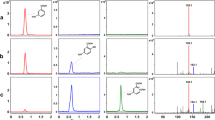Abstract
Nucleotide sequence extending 2,3-dihydroxybiphenyl 1,2-dioxygenase gene (pcbC) and 2-hydroxy-6-oxo-6-phenylhexa-2,4-dienoate hydrolase gene (pcbD) ofPseudomonas sp. DJ-12 was previously analyzed and the two genes were present in the order ofpcbD-pcbC preceded by a promoter fromPseudomonas sp. DJ-12. In this study, a 3.8-kb nucleotide sequence located downstream of thepcbC gene was analyzed to have three open reading frames (ORFs) that are designated asorf1, pcbE andorf2 genes. All of the ORFs were preceded by each ribosome-binding sequence of 5-GGAXA-3 (X=G or A). However, no promoter-like sequence and transcription terminator sequence were found in the analyzed region, downstream ofpcbC gene. Therefore, the gene cluster appeared to be present in the order ofpcbD-pcbC-orf1-pcbE-orf2 as an operon, which is unique organization characterized so far in biphenyl- and PCB-degrading bacteria. Theorf1 gene was composed of 1,224 base pairs which can encode a polypeptide of molecular weight 44,950 containing 405 amino acid residues. A deduced amino acid sequence of theorf1 gene product exhibited 21–33% identity with those of indole dioxygenase and phenol hydroxylase components. ThepcbE gene was composed of 783 base pairs encoding 2-hydroxypenta-2,4-dienoate hydratase involved in the 4-chlorobiphenyl catabolism. Theorf2 gene was composed of 1,017 base pairs encoding a polypeptide of molecular weight 37,378 containing 338 amino acid residues. A deduced amino acid sequence of theorf2 gene product exhibited 31% identity with that of a nitrilotriacetate monooxygenase component.
Similar content being viewed by others
References
Abramowicz, D. A., Aerobic and anaerobic biodegradation of PCBs: a review.Biotechnology, 10, 241–251 (1990).
Ahmed, M., and Focht, D. D., Degradation of polychlorinated biphenyls by two species ofAchromobacter.Can. J. Microbiol., 19, 47–52 (1973).
Bedard, D. L., Wagner, R. E., Brennan, M. J., Haberl, M. L., and Brown, Jr. J. F., Extensive degradation of Aroclors and environmentally transformed polychlorinated biphenyls byAlcaligenes eutrophus H850.Appl. Environ. Microbiol., 53, 1094–1102 (1997).
Bopp, L. H., Degradation of highly chlorinated PCBs byPseudomonas strain LB400.J. Ind. Microbiol., 1, 23–29 (1986).
Engel, C. K., Mathieu, M., Zeelen, J. P., Hiltunen, J. K., and Wierenga, R. W., Crystal structure of enoylcoenzyme A (CoA) hydratase at 2.5 A resolution: a spiral fold defines the CoA-binding pocket.EMBO J., 15, 5135–5145 (1996).
Furukawa, K., and Chakraberty, A. M., Involvement of plasmids in total degradation of chlorinated biphenyls.Appl. Environ. Microbiol., 44, 543–548 (1982).
Furukawa, K., Matsumura, F., and Tonomura, K.,Alcaligenes andAcinectobacter strains capable of degrading polchlorinated biphenyls.Agric. Biol. Chem., 42, 543–548 (1978).
Furukawa, K., Hayase, N., Taira, K., and Tomizuka, N., Molecular relationship of chromosomal genes encoding biphenyl/polychlorinated biphenyl catabolism: some soil bacteria possess a highly conservedbph operon.J. Bacteriol., 171, 5467–5472 (1989).
Hayase, N., Taira, K., and Furukawa, K.,Pseudomonas putida KF715bphABCD operon encoding biphenyl and polychlorinated biphenyl degradation: cloning, analysis, and expression in soil bacteria.J. Bacteriol., 172, 1160–1164 (1990).
Hofer, B., Eltis, L. D., Dowling, D. N., and Timmis, K. N., Genetic analysis of aPseudomonas locus encoding a pathway of biphenyl/polychlorinated biphenyl degradation.Gene, 130, 47–55 (1993).
Hutzinger, O., Safe, S., and Zitko, V., The Chemistry of PCB’s. CRC Press, Inc., Cleveland (1974).
Khan, A. A., and Walia, S. K., Expression, localization, and functional analysis of polychlorinated biphenyl degradation genescbpABCD ofPseudomonas putida.Appl. Environ. Microbiol., 57, 1325–1332 (1991).
Kikuchi, Y., Yasukochi, Y., Nagata, Y., Fukuda, M., and Takagi, M., Nucleotide sequence and functional analysis of themeta-cleavage pathway involved in biphenyl and polychlorinated biphenyl degradation inPseudomonas sp. KKS102.J. Bacteriol., 176, 4269–4276 (1994).
Kim, C.-K., Chae, J. C., and Kim, Y.-C., Isolation and characterization of bacteria degrading chlorinated aromatic hydrocarbons.Kor. J. Microbiol., 25, 122–128 (1987).
Kim, C.-K., Kim, E., Chae, J. C., and Kim, Y., Structure of thepcbC encoding 2,3-dihydroxybiphenyl dioxygenase ofPseudomonas sp. P20.Biochem. Biophys. Res. Commun., 226, 15–20 (1996a).
Kim, C.-K., Sung, T.-K., Nam, J. H., Kim, Y.-C., and Lee, J. K., Cloning and expression ofpcbCD genes inEscherichia, coli fromPseudomonas sp. DJ-12.Kor. J. Microbiol., 32, 40–46 (1994).
Kim, E., Kim, Y., and Kim, C.-K., Genetic structure of the genes encoding 2,3-dihydroxybiphenyl 1,2-dioxygenase and 2-hydroxy-6-oxo-6-phenylhexa-2,4-dienoic acid hydrolase from biphenyl- and 4-chlorobiphenyl-degradingPseudomonas sp. strain DJ-12.Appl. Environ. Microbiol., 62, 262–265 (1996b).
Kimbara, K., Hashimoto, T., Fukuda, M., Koana, T., Takagi, M., Oishi, M., and Yano, K., Cloning and sequencing of two tandem genes involved in degradation of 2,3-dihydroxybiphenyl to benzoic acid in the polychlorinated biphenyl-degrading soil bacteriumPseudomonas sp. strain KKS102.J. Bacteriol., 171, 2740–2747 (1989).
Masai, E., Yamada, A., Healy, J. M., Hatta, T., Kimbara, K., Fukuda, M., and Yano, K., Characterization of biphenyl catabolic genes of Gram-positive polychlorinated biphenyl degradaerRhodococcus sp. strain RHA1.Appl. Environ. Microbiol., 61, 2079–2085 (1995).
Mondello, F. J., Cloning and expression inEscherichia coli ofPseudomonas strain LB400 genes encoding polychlorinated biphenyl degradation.J. Bacteriol., 171, 1725–1732 (1989).
Normore, W. M.,Handbook of Biochemistry and Molecular Biology, Fasman, G. D. (ed.), Vol. 3, p. 65–235, The Chemical Rubber Co., Cleveland (1976).
Sambrook, J., Fritsch, E. F., and Manniatis, T.,Molecular Cloning: A Laboratory Manual, Cold Spring Harbor Laboratory, Cold Spring Harbor, New York (1989).
Seeger, M., Timmis, K. N., and Hofer, B., Conversion of chlorobiphenyl into phenylhexadienoates and benzoates by the enzymes of the upper pathway for polychlorobiphenyl degradation encoded bybph locus ofPseudomonas sp. strain LB400.Appl. Environ. Microbiol., 61, 2654–2658 (1995).
Taira, K., Hirose, J., Hayashida, S., and Furukawa, K., Analysis ofbph operon from the polchlorinated biphenyl-degrading strain ofPseudomonas pseudoalcaligenes KF707.J. Biol. Chem., 267, 4844–4853 (1992).
Yagi, O., and Sudo, R., Degradation of polychlorinated biphenyls by microorganisms.J. Water Pollut. Control. Fed., 52, 1035–1043 (1980).
Author information
Authors and Affiliations
Corresponding author
Rights and permissions
About this article
Cite this article
Lim, JC., Lee, J., Jang, J.D. et al. Characterization of thepcbE gene encoding 2-hydroxypenta-2,4-dienoate hydratase inPseudomonas sp. DJ-12. Arch Pharm Res 23, 187–195 (2000). https://doi.org/10.1007/BF02975512
Received:
Issue Date:
DOI: https://doi.org/10.1007/BF02975512




